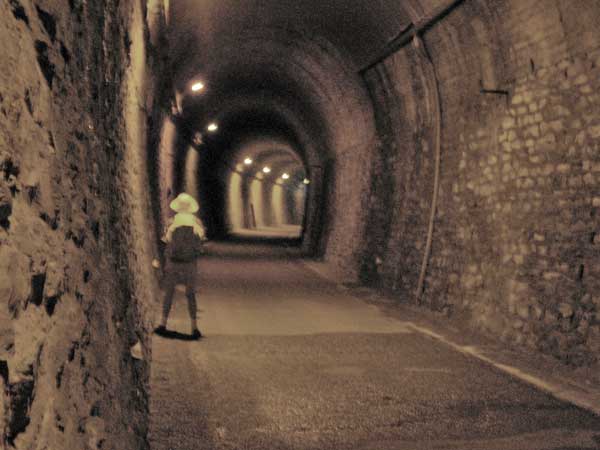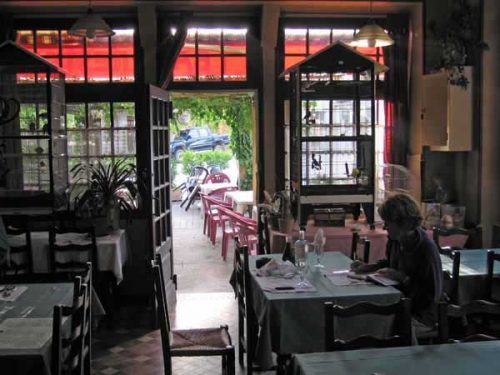Thursday, 5 July 2007
Distance 31 km
Duration 6 hours 15 minutes
Ascent 201 m, descent 248 m
Map 65 of the TOP100 blue series (now superseded)

I swept my almost dry muesli back into its bag, after eating a small amount, and we crept out the back door that our host had shown us, just before 7 am.
Once through the yard gate and back on the bitumen, we turned uphill towards the village, having decided to take Alain’s advice.
First thing in the morning it did not seem far at all, and we picked up fresh bread on our way through. Down the other side was a pleasant, airy walk on the deserted road.
Before long we were back at river level, joining another road that came over a bridge from the valley of the Dourdou opposite, where the tunnels were. It was all a bit of a mystery, since there were no great walls of rock to get through, only rolling forested hills.

Soon afterwards we were surprised to come to another tunnel, one that we had not noticed on the map. It was narrow, pitch black and 450 metres long, with a one-way system operated by red and green lights.
Drivers and cyclists were instructed to turn on their headlights. We decided we were too young to walk through it, and fortunately there was an alternative, a wheel track around the riverbank. We ignored the No Entry sign, as Alain had advised.
It was a long way round, because the river made a long loop at this point, but it was hard to see why a tunnel was necessary all the same.

With some difficulty we made it to the tunnel exit, after which the road immediately crossed the river on an odd-looking iron bridge, and continued beside the river, until we were even more puzzled to see another tunnel entrance, not on the road but half-hidden in shrubbery a few steps off it.
Next to the entrance was an information board that suddenly made sense of the whole mystery – it was an old railway line!
The tunnels, bridges, embankments and cuttings had been constructed in the early twentieth century, by a company building a railway line to transport Roquefort cheese from Saint-Affrique to Albi (the caves in which the legendary cheese is matured are at Roquefort-sur-Soulzon, a few kilometres beyond Saint-Affrique).

The great depression ruined the project even before the rails were laid, and eventually the track bed was covered with a strip of bitumen, making a narrow but precisely graded road.
The austere silhouette of the towers of Brousse-le-Château appeared on an outcrop of rock over the river. A sign said it was a Plus Beau Village but we were inclined to scoff, as it looked plain and dull.
We quickly changed our minds when we crossed the bridge and entered the village itself, which was behind the château and linked to it by a steeply hump-backed bridge, whose cobbles gleamed in the morning light.

The place was charming and best of all, there was a Logis de France hotel on the square, where guests were having late breakfasts (it was 9:20 am).
We were courteously received and shown to an unlaid corner table. It was too cold to countenance sitting outside. The coffee and the refined surroundings were equally enjoyable, and we set off again without a care in the world.
Now that we knew we were on an old railway line, we noticed the typical cast-iron railings on the embankments, with bolt-holes for workers to retire into when a train came by. We should have guessed what it was.

We crossed the river on another iron bridge and made quick progress down the right bank until we approached Lincou, where our little road went into a tunnel (fortunately with overhead lighting), and did not emerge until the village was behind us, so we never saw it.
On we went beside the widening river, until we reached a large barrage at Combradet.

Just past it was another tunnel, a dark one, so Keith got out his tiny, powerful torch and we entered gingerly, but it turned out to be very short – we need not have bothered with the torch.
The department of Aveyron gave way to Tarn, the only difference being the loss of the stone kilometre markers beside the road, with which we had been amusing ourselves by timing our progress.

We went though a long stretch of featureless forest. It was time for lunch but there was nowhere to stop until we came to a newly-mown field descending to the river. This provided a splendid picnic spot, with the added virtue of the smell of the cut grass.
A couple of kilometres further on was yet another barrage, with the village of Trébas beyond.

It was small but very well endowed. It had a bar, a restaurant, a little supermarket, an Office of Tourism and a camping ground a few metres away, on the river.
We had celebratory coffee at the bar, made sure that the restaurant would be open that evening, and sampled the sausage and cheese at the shop before buying some for future lunches.
Unfortunately they did not have the map we needed for the next day (TOP100 number 64), but we got a map of Albi at the Office, together with a list of camping grounds for the department of Tarn.

At the camping ground, the grass was as thick as a mattress and newly mown. Tents and caravans were distributed here and there under the trees, and the ground was as soft as butter, so I made a generous hip-hole with no trouble.
A big inflatable pool nearby was crowded with holiday makers but we thought it much too cool for such a thing. The shower block carried an elaborate mural of sea creatures, probably painted by the manager in the off-season, and the showers themselves were magnificent.
It had been a long time since we had had to endure the tepid push-button showers in concrete stalls that used to be the standard when we first began walking in France.

Before dinner we took a glass of rosé at the makeshift outdoor bar in the camping ground, where our jovial host was trying, between customers, to attach a bird-feeder to a post. He finally succeeded and we all clapped.
We asked him which side of the river would be best to walk down tomorrow, as there was a road on both sides below Trébas.
To our surprise he recommended the left side, which was wider but less used, he said, than the erstwhile railway track continuing on the right.

He also announced to the assembled drinkers that he had heard the weather forecast – summer would start tomorrow afternoon and end two days later, on Sunday.
At the restaurant in the village, we were the only inhabitants of the dining room, apart from some caged birds, although there were plenty of drinkers next door in the bar.
I had a fine coq au vin and Keith had the local speciality, Roquefort lasagne, which he maintained was delicious. It was only a few steps to get back to the tent for another luxurious night beside the Tarn.
Previous day: St-Rome-de-Tarn to Broquiès